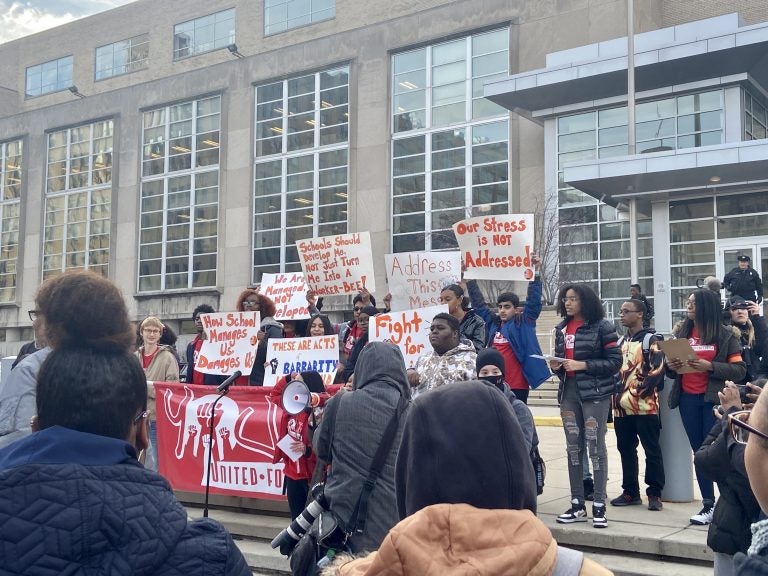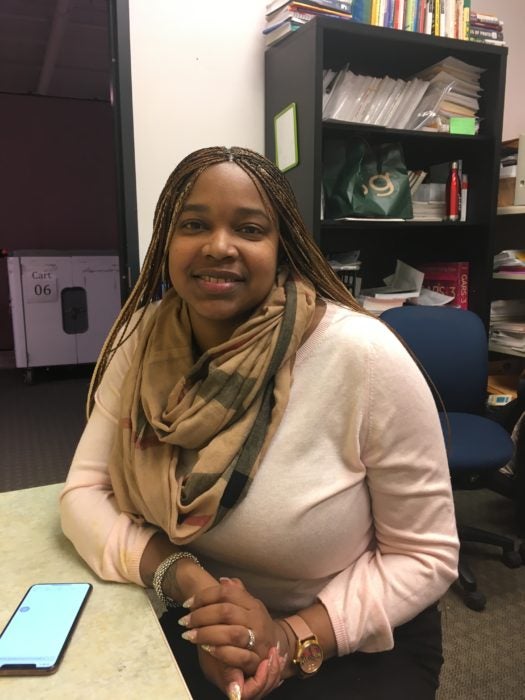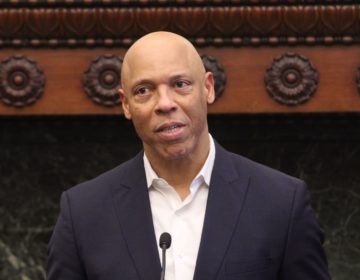In Philly, creating more trauma-informed schools requires a change of culture
“The world of thinking about trauma, the importance of school climate and social-emotional learning is 20, 30, 40 years behind the world of instruction."

Students rally outside School District headquarters on Jan. 30 demanding better mental health services in schools. (Courtesy of Rebekah Canty)
This article originally appeared on The Notebook.
—
Joanna Schwartz, a second-grade teacher at Eliza B. Kirkbride Elementary School, was about to take a scheduled break and desperately needed a place to have peace and quiet.
But the only place she could find was a broom closet.
A few years earlier, in another school, Schwartz said teachers were baffled by a third grader who continually fell asleep in class. Was he bored? Hostile? Disrespectful?
None of the three, as it turned out.
His mother had been found dead in a field and this made him afraid to fall asleep. “So he stayed up all night watching videos.”
To prevent scenes like these from happening, schools around the country are turning to trauma-informed education, creating an atmosphere that makes it easier for students to learn and teachers to teach.
In a trauma-informed school, Schwartz would have had a place to recharge her batteries and the source of the third-grader’s sleepiness would have been discerned much earlier.
A challenge for urban districts
But in large urban districts, particularly those like the School District of Philadelphia with their high rates of poverty, creating so-called trauma-informed schools is proving to be a challenge.
“It’s something that urban districts across the country are trying to learn,” said Abigail Gray, deputy chief of the District’s Office of Climate and Safety. “In under-resourced settings with not enough adults, too many kids, where trauma affects 70% of your kids, the challenges are gigantic.”
Jayme Banks, who joined the District in May as deputy chief of prevention and intervention, said that the District soon will release a comprehensive plan for spreading trauma-informed education through the school system.
The plan will be based on a “whole-school approach,” she said, a change from the District’s earlier plan of simply training as many personnel as possible in the principles of trauma-informed education.
Community Behavioral Health, which provides some school-based services, will also be unveiling changes in its school-based services for 2020-2021 that will place greater emphasis on evidence-based treatments. Officials there say they are also placing greater emphasis on trauma-informed education.
From August 2017 to the start of this year, 89 District schools have participated in trauma training run by the Lakeside Global Institute. But this is less than half of the District’s 250 schools.
All told, Lakeside has also provided training to more than 9,000 individuals in the city – teachers, administrators, non-teaching personnel and some parents, much of it with financial support from United Way of Greater Philadelphia and New Jersey.
But teachers have often had to go on their own time instead of accessing the training during paid professional development sessions at schools.
Beth Hall, director of administration at Lakeside, said that in most cases, schools offered the training “have been positive and receptive and jumped on it.”
Not in all cases, however. She said that 32 schools didn’t respond to emails.
Addressing trauma helps academics
And acceptance is not universal.
“What I hear from teachers,” said Tawanna Jones, a school psychologist at Abraham Lincoln High School in Northeast Philadelphia, “is that if they’re implementing trauma-informed practices, they could be penalized. If you come in and see students meditating (a common trauma-informed practice ), it doesn’t look like curriculum.”

A former District official who asked not to be identified said that while they felt that Superintendent William Hite is a strong supporter of trauma-informed education, “it hasn’t really penetrated the (administrative) layers between Hite and the individual schools.”
The former official said that with some District principals and other leaders, the emphasis remains strictly on “how to get the test scores up.”
Karyn T. Lynch, the District’s Chief of Support Services, said last week that “within schools, we have varying degrees of readiness for a trauma-informed approach to learning and supports.
“To say that every single school, given the exact same treatment, is going to have the same result, that is not the case.”
But Lynch says that the vocabulary of social-emotional learning and trauma-informed education has been implanted in every school, and that “we have more today than we have had in the past.”
She also cites the presence of more clinical coordinators and family peer coordinators in the schools.
She noted that the District’s full-court press on increasing attendance has reaped results. In School Progress Reports for last year, released on Monday, much of the overall improvements were due to better climate scores, which includes attendance.
And one way to increase attendance is to make schools places where students feel nurtured and want to come to, Lynch and experts on trauma-informed education say. She adds that better attendance is a necessary condition for academic progress.
Hite shares this message in regular meetings with principals and other school leaders, she said. Plus, he has gotten feedback from students themselves, who have said it is “extremely important” for schools to pay attention to their mental health issues. A group of students held a rally prior to the January Board of Education meeting to dramatize the issue.
“We know this is important,” she said. “Once a child is able to self-regulate, has good relationships within a school, then a child is able to recognize, ‘this is a place I want to be,’ attendance is increased, and then you have the opportunity to educate the child.”
To help teachers better connect the dots between addressing trauma and improving academic achievement, she said, the District has tracked policies implemented elsewhere. For instance, some districts include social and emotional learning practices in their formal educator evaluations.
“We have looked at models that have been successful in other places in the country, and we recognize the benefits of those models and moving in that direction,” she said.
Still, an obstacle — in Philadelphia and elsewhere — is the relative newness of the concepts of trauma-informed education and the larger subject of social and emotional learning, or SEL.
For educators, “the world of thinking about trauma, the importance of school climate and SEL is 20, 30, 40 years behind the world of instruction,” said Gray, of the District’s climate office.
“The institutional investment at this level is nowhere near the level of the instructional sides. We have to be social and emotional providers to our kids, and that’s something new.”
Plus, “The ed schools don’t teach this stuff.”
Schwartz — who also has a social work background — has assembled an informal group of teachers in her school that meets weekly to discuss trauma and SEL issues.
But on the whole, she said, “The teachers I work with don’t know much about trauma…You need continuing coaching. Not a one-and-done thing.”
In a March 2019 report, Philadelphia-based Research for Action cited several examples of successful trauma-informed education efforts, including the Pottstown School District, the Mastery Schools charter network and, on a state level, Massachusetts.
The Notebook’s Dale Mezzacappa contributed reporting.
WHYY is your source for fact-based, in-depth journalism and information. As a nonprofit organization, we rely on financial support from readers like you. Please give today.




